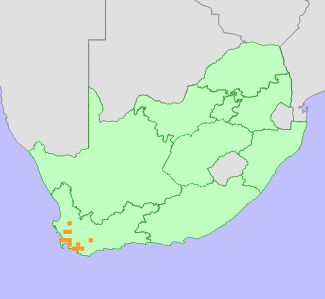|
Scientific Name | Hesperantha radiata (Jacq.) Ker Gawl. subsp. caricina (Ker Gawl.) J.C.Manning & Goldblatt |
Higher Classification | Monocotyledons |
Family | IRIDACEAE |
Synonyms | Hesperantha angustifolia Loudon (superfluous name), Hesperantha caricina (Ker Gawl.) Klatt (superfluous name), Hesperantha radiata (Jacq.) Ker Gawl. var. caricina Ker Gawl., Hesperantha tenuifolia Salisb. |
National Status |
Status and Criteria | Near Threatened B1ab(i,ii,iii,iv,v)+2ab(i,ii,iii,iv,v) |
Assessment Date | 2021/06/21 |
Assessor(s) | L. von Staden & T. Patel |
Justification | This subspecies has an extent of occurrence (EOO) of 14 813 km² and an area of occupancy (AOO) of 88 km². It is known from 13 to 18 locations, which are continuing to decline due to ongoing habitat loss, degradation, and competition from alien invasive plants. Therefore, it is listed as Near Threatened, almost meeting the criteria to be classified as Vulnerable under criterion B. |
Distribution |
Endemism | South African endemic |
Provincial distribution | Western Cape |
Range | It is endemic to South Africa, and is restricted to the southwestern corner of the Western Cape, occurring from Piketberg and Riebeeck Kasteel in the north to Hermanus in the southeast. |
Habitat and Ecology |
Major system | Terrestrial |
Major habitats | Swartland Shale Renosterveld, Western Ruens Shale Renosterveld, Peninsula Shale Renosterveld, Swartland Granite Renosterveld, Peninsula Granite Fynbos, Boland Granite Fynbos, Elim Ferricrete Fynbos, Lourensford Alluvium Fynbos |
Description | It often occurs in sandy ground, on rocky clay soils on lower slopes and flats. |
Threats |
| This subspecies is declining due to ongoing loss, fragmentation and degradation of its lowland renosterveld habitat, mainly due to agricultural and urban expansion, as well as competition from alien invasive plants. |
Population |
It was only recently recognized as distinct from the widespread and common Hesperantha radiata, and is currently known from only a few records, mostly historical, with imprecise locality details. Further surveys are necessary to determine the size and extent of the remaining subpopulations. One subpopulation recorded in the Overberg District Municipality had fewer than 10 plants present in 2020. The population is decreasing.
|
Population trend | Decreasing |
Assessment History |
Taxon assessed |
Status and Criteria |
Citation/Red List version | | Hesperantha radiata (Jacq.) Ker Gawl. subsp. caricina (Ker Gawl.) J.C.Manning & Goldblatt | NT B1ab(i,ii,iii,iv,v) | 2014.1 | | Hesperantha radiata (Jacq.) Ker Gawl. | Least Concern | Raimondo et al. (2009) | | Hesperantha tysonii Baker | Lower Risk - Least Concern | Scott-Shaw (1999) | |
Bibliography |
Goldblatt, P. and Manning, J.C. 2012. New species and subspecies of Babiana, Hesperantha, and Ixia (Iridaceae: Crocoideae) from southern Africa; range extensions and morphological and nomenclatural notes on Babiana and Geissorhiza. Bothalia 42(2):137-145.
Goldblatt, P. and Manning, J.C. 2020. Iridaceae of southern Africa. Strelitzia 42. South African National Biodiversity Institute, Pretoria.
|
Citation |
| von Staden, L. & Patel, T. 2021. Hesperantha radiata (Jacq.) Ker Gawl. subsp. caricina (Ker Gawl.) J.C.Manning & Goldblatt. National Assessment: Red List of South African Plants version 2024.1. Accessed on 2025/10/26 |
 Comment on this assessment
Comment on this assessment


